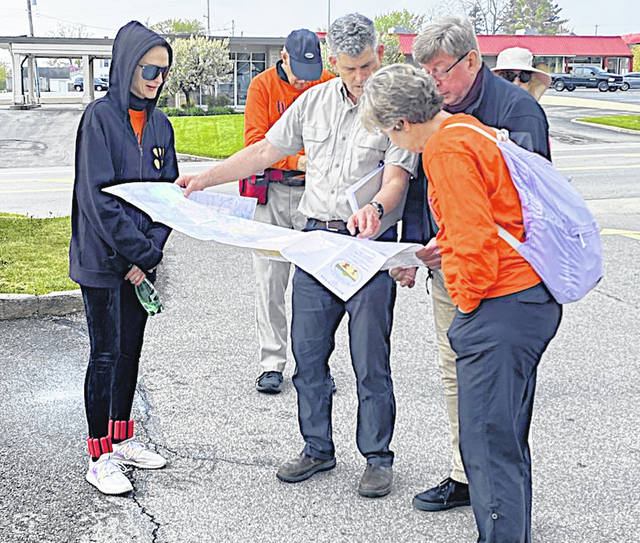
In bright orange T-shirts bearing a “Walking Ancient Ohio” logo, a group of people set out from Greenfield’s historical complex recently with the intent of covering 14 miles by foot to a point on U.S. Route 50 where they began a five-mile canoe journey to Seip Mound in Bainbridge.
The next day they were to cover 17 miles, with that leg of the journey bringing them by all the other associated earthworks — Hopewell, Mound City, Hopeton and High Bank — in Chillicothe as they make their way toward Newark in the coming weeks.
Every other weekend, former Ohio first lady Hope Taft and retired Cincinnati lawyer Buck Niehoff, joined by various others on different parts of the journey, are connecting the earthworks and covering nearly 150 miles between Fort Ancient and Newark, all together known as the Hopewell Ceremonial Earthworks.
For Taft and Niehoff and all those that join them as they “find a path” from Fort Ancient to Newark, it is about experiencing the places along the way that are off the beaten path. The importance of their walk beyond linking the sites is to showcase that each of the sites can be reached without taking the interstate, and by doing so one gets a more complete picture of Ohio and the historical significance and charm that each town along the way has to offer.
Sunday they were joined by Jim Scott, retired WLW radio host, and his wife, Donna Hartman; Cincinnati native and former New York City attorney Melody Sawyer Richardson; Ohio Sen. Steve Wilson and his wife, Jill; Ohio Department of Natural Resources Director Mary Mertz; Aaron Rourke, ODNR scenic river program manger; Kristina Rastaturina; and Gary Meisner, landscape architect and president of Scenic Ohio, who drives the group’s chase car. Also joining them April 25 on the creek were seven paddlers, all part of a group of marathon canoe racers, a group who has among its ranks 99-year-old Mike Fremont. While Fremont wasn’t on the creek with them that day, Taft said when they put out the call for strong paddlers, Fremont’s group answered.
That large area of earthworks were all made by the same people.
The site as a whole was first applied for consideration to the UNESCO World Heritage Sites in 2008. Now, a dossier is being compiled on the site, and the project will then move onto an international committee before a final approval, which could happen in the next couple of years, Taft said.
Part of the reason it has taken so long, she said, is likely because of the “unusual conglomeration” of the sites stretching across Southern and Central Ohio.
The Hopewell sites tell of what Taft called a fascinating culture, one that appears to have been harmonious with nature and other peoples, hunter gatherers who built massive earthworks one basketful of dirt at a time, and with no written records found, they likely passed on knowledge and tradition through an incredible oral history.
Additionally, Niehoff noted that the the five circles contained in the whole site are all the same circumference, and the sophistication of the culture is further made known in the astrological elements of the creations, particularly with the Octagon Earthworks in Newark where the moon’s rise at its most northerly position on the horizon is seen within the earthwork. It’s an alignment that happens in an 18.6-year cycle.
It was noted that Serpent Mound is not a part of the Hopewell sites as it was different Native American people that built it. However, the site is on the tentative list on the UNESCO World Heritage website.
The Hopewell Ceremonial Earthworks being a World Heritage Site will draw tourists to the area, they said. As an economic study had to be completed as part of the application process, it was estimated that the site as a whole could attract more than 200,000 people per year.
There are only 24 World Heritage Sites in the United States, which include places like the Statue of Liberty, Grand Canyon, Great Smoky Mountains, Independence Hall, Yellowstone and Yosemite.
The global list includes well-known places including the Galapagos Islands, Taj Mahal, Angkor Wat, Machu Picchu, Great Wall of China, and the Pyramid Fields from Giza to Dahshur in Egypt.
To be listed among those places, both Taft and Niehoff said, is no small feat.
Niehoff said that as they planned the journey there was some apprehension because of traffic along the state routes and country roads. However, they have found folks to be courteous, with drivers swerving well around them and some people even stopping for chats.
That friendliness was extended in Greenfield, too, as Catch 22 was opened Sunday morning just to welcome the traveling guests before they began their walk. Greenfield council member Phil Clyburn, Casey McIntosh with the Highland County Visitors Bureau, and Grow Greater Greenfield (G3) member Susan Howland shared in the story of why Taft and Niehoff are doing this and expressed gratitude to the duo for what they are doing.
“We want to highlight the wonderful things people can see if they just get off the expressways,” Taft said.
Angela Shepherd is a correspondent for the village of Greenfield.


